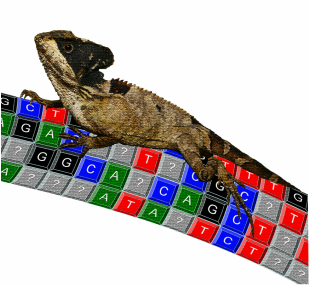High-throughput systematicsHigh-throughput DNA sequencing (a.k.a. next-generation sequencing) has revolutionised the way that biologists collect DNA sequence data by allowing for hundreds to thousands of unique genomic regions to be obtained from non-model species. We are using targeted sequence capture of ultraconserved elements (UCEs) to explore the utility of these methods for resolving difficult phylogenetic relationships in amphibians and reptiles.
|
Project overview
|
Amphibians first appeared during the Devonian (ca. 370 mya) and reptiles during the Carboniferous (ca. 312 mya). Since their respective origins, each group has diversified tremendously. Both groups contain lineages that have experienced periods of rapid diversification. Understanding relationships within these "rapid radiations" has proven difficult when using traditional multilocus datasets (< 50 genes), particularly when the rapid diversification happened a long time ago (e.g. pleurodont lizards). This series of projects will ask the following questions: (1) can phylogenomic sampling resolve difficult relationships with statistical support, and (2) how are sampling effects related to taxa and data completeness relevant when dealing with hundreds or thousands of loci?
Related publications: Streicher, J.W., Loader, S.P., Varela-Jaramillo, A., Montoya, P. and R.O. de Sá. 2020. Analysis of ultraconserved elements supports African origins of narrow-mouthed frogs. Molecular Phylogenetics and Evolution. In Press. Streicher, J.W., Miller, E.C., Guerrero, P.C., Correa, C., Ortiz, J.C., Crawford, A.J., Pie, M.R. and J.J. Wiens. 2018. Evaluating methods for phylogenomic analyses, and a new phylogeny for a major frog clade (Hyloidea) based on 2,214 loci. Molecular Phylogenetics and Evolution 119: 128-143 [DOI:10.1016/ympev.2017.10.103] Streicher, J.W. and J.J. Wiens. 2017. Phylogenomic analyses of more than 4,000 nuclear loci resolve the origin of snakes among lizard families. Biology Letters 13: 2017.0393 [DOI:10.1098/rsbl.2017.0393] Streicher, J.W. and J.J. Wiens. 2016. Phylogenomic analyses reveal novel relationships among snake families. Molecular Phylogenetics and Evolution 100: 160-169 [DOI:10.1016/j.ympev.2016.04.015] Streicher, J.W., Schulte II, J.A. and J.J. Wiens. 2016. How should genes and taxa be sampled for phylogenomic analyses with missing data? An empirical study in iguanian lizards. Systematic Biology 65: 128-145 [DOI:10.1093/sysbio/syv058] |
Collaborators
|
John Wiens, Professor, University of Arizona, Tucson, Arizona, USA
Andrew Crawford, Associate Professor, University of the Andes, Bogota, Colombia James Schulte II, Associate Professor, Beloit College, Beloit, Wisconsin, USA Elizabeth Miller, PhD student, University of Arizona, Tucson, Arizona, USA Lucas Barrientos, PhD student, University of the Andes, Bogota, Colombia Pablo Guerrero, Botany Department, Universidad de Concepción, Concepción, Chile Claudio Correa, Zoology Department, Universidad de Concepción, Concepción, Chile Juan Ortiz, Zoology Department, Universidad de Concepción, Concepción, Chile Marcio Pie, Associate Professor, Universidade Federal do Paraná, Brazil |

